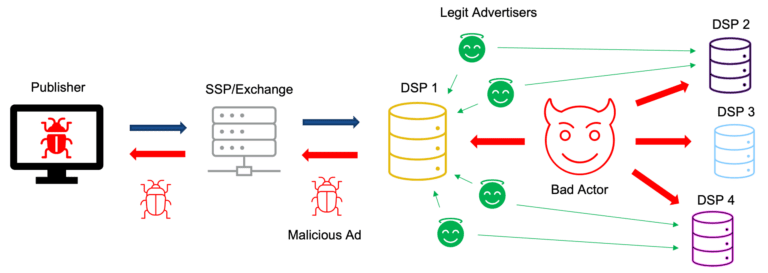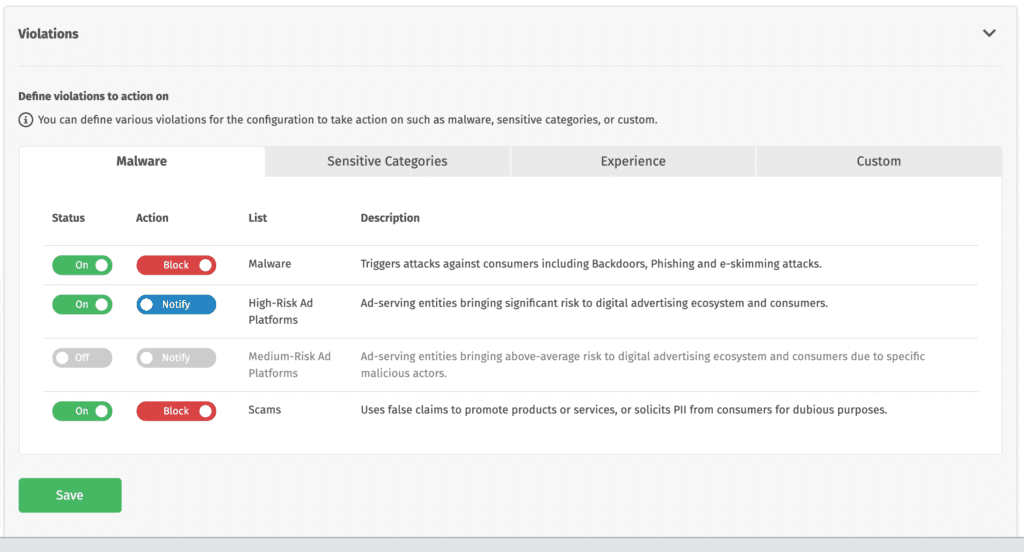Media Filter has some serious upgrades—including the ability to block sensitive categories, scams, and high- and medium-risk a platforms.
While malvertising in the digital space is reaching dizzying new heights, publishers are demanding something more than a bad-ad blocker. They still have to slap down redirects and kick other malware to the curb, but beyond that they need to ensure high-quality ad experiences. Future revenue depends on publishers tightening their relationships with audiences, which means advanced controls over the kinds of ads and platforms trying to crawl onto their sites.
That’s why Media Filter has evolved from the fastest and smartest bad-ad blocker on the market to the ultimate real-time ad-quality manager. In addition to the best-sourced malware prevention available, Media Filter now offers blocking and notification on:
- potentially offensive or sensitive ad content;
- High- and Medium-Risk Ad Platforms;
- heavy ads slowing down page loads; and
- low-quality, scam and deceptive advertising.
Oh yeah—it’s still fast as hell, and actually even smarter now.
1. Feeling Sensitive
Let’s start with the big one: Media Filter now offers the ability to block or notify on 15 sensitive categories, including Adult Content and Products, Alcohol, Gambling, Marijuana, Political, Pharmaceutical, and more. You’ll notice these are not just content areas that could offend audiences, but also highly regulated ad verticals.
Even cooler, though, is that the sensitive creative is evaluated by our proprietary Ad Categorization system, developed alongside major AdTech platforms and publishers. We use AI to evaluate display creative at scale, identifying which fit into sensitive content categories. Then Media Trust analysts (who have human eyes—we checked) verify the results to ensure an industry-low false-positive rates.
2. Tell Scams to Scram
You know the ads—low-quality creative that lead to scummy websites pushing products filled with false claims and promises to hook you up with a super low-rate mortgage but actually sell your data to countless other companies in every vertical imaginable.
In addition to hunting down malware like auto-redirects, software-install prompts, phishing attacks, and other dastardly malware, The Media Trust’s Digital Security & Operations team is also stalking scam and deceptive advertising across the web. Exposing malware can sometimes be easier because the truth is written in the code (no matter how obscured). Unmasking scams and deceptive advertising requires painstaking research into the end advertiser to ensure an actor is working in bad faith. And this information isn’t just for publishers—upstream ad tech partners (SSPs and DSPs) that strive to be high-quality demand resources want to keep shady advertisers off their platforms. It’s in their interest to shut scammers down.
Exposing malware can sometimes be easier because the truth is written in the code (no matter how obscured). Unmasking scams and deceptive advertising requires painstaking research into the end advertiser to ensure an actor is working in bad faith.
3. Pick a Risk, Any Risk
The Digital Security & Operations team also keeps track of what ad platforms are more prone to serve malvertising—that is, the preferred platforms of bad actors. We have a sophisticated scoring system based on numerous factors, including the amount of malvertising we’ve seen delivered by a platform and an investigation of its history in the space. Using this, we identify certain platforms as high-risk and others as medium-risk, and enable blocking or notification in the Media Filter configuration screen.
The Media Trust has always advocated for precision blocking—stopping specific malware attacks rather than just cutting off demand partners. Malvertisers are equal-opportunity offenders, spreading their evil wares across any platform that might be tricked into having them. All kinds of “good” or “low-risk” platforms get wrapped up in malicious campaigns, so focusing on high- or medium-risk ones with blunt-force blocking could actually take your eye off the ball and leave you vulnerable to a malvertising barrage (see Figure 1). Plus you can lose out on revenue opportunities by simply blocking ad platforms that might have a checkered past.

Still, every publisher should be able to set its own risk profile, and many a premium one will decide that the revenue opportunities are not worth letting in high- and medium-risk ad platforms. In addition, during major malvertising outbreaks—where malware seems to be coming from any and every direction—the ability to turn off high- and medium-risk ad platforms could serve as triage. The point is you need the choice in controlling your own risk profile.
4. Things Get Heavy
We’ve all been there—click on a page and some of the content starts loading… but then it freezes. You check your Internet connection—no, it’s not you. Still no more loading, and when you scroll down it’s endless white. You look in the lower corner and recognize a URL from an AdTech company (well, if you’re in the industry you probably recognize the name). Yup, your experience probably just got whacked by a super heavy ad loading.
The Media Trust can put a stop to that—nip those heavy ads in their oversized posterior with heavy ad blocking in Media Filter!
5. Configure With Ease
Setting up your real-time ad-quality policies really is as easy as flipping a switch. Media Filter’s revamped configuration screen is simpler than ever to use: just head to the relevant tab (Malware, Sensitive Categories, or Experience) turn a blocklist on, and then decide whether to block or notify.

At the same time, Media Filter remains a highly flexible tool, enabling separate configurations for each publisher domain or groups of domains. In addition, custom blocklists (e.g., competitors) can be uploaded in bulk, and then amended within the Custom tab. Finally, turn on Redirect Deterrent to freeze redirect code while still monetizing the impression—that’s right, make the scammers pay!
The Enforcer
Publishers don’t need a bad ad blocker—they need a real-time ad quality management solution that includes the ability to block on sensitive ad content categories; heavy ads slowing down page loads; and low-quality, scam and deceptive advertising. These options and more are essential for a publisher to establish its risk profile and acceptable creative policy.
It’s your site, your inventory—you need strict rules about what you’ll tolerate. Let Media Filter be the enforcer.

